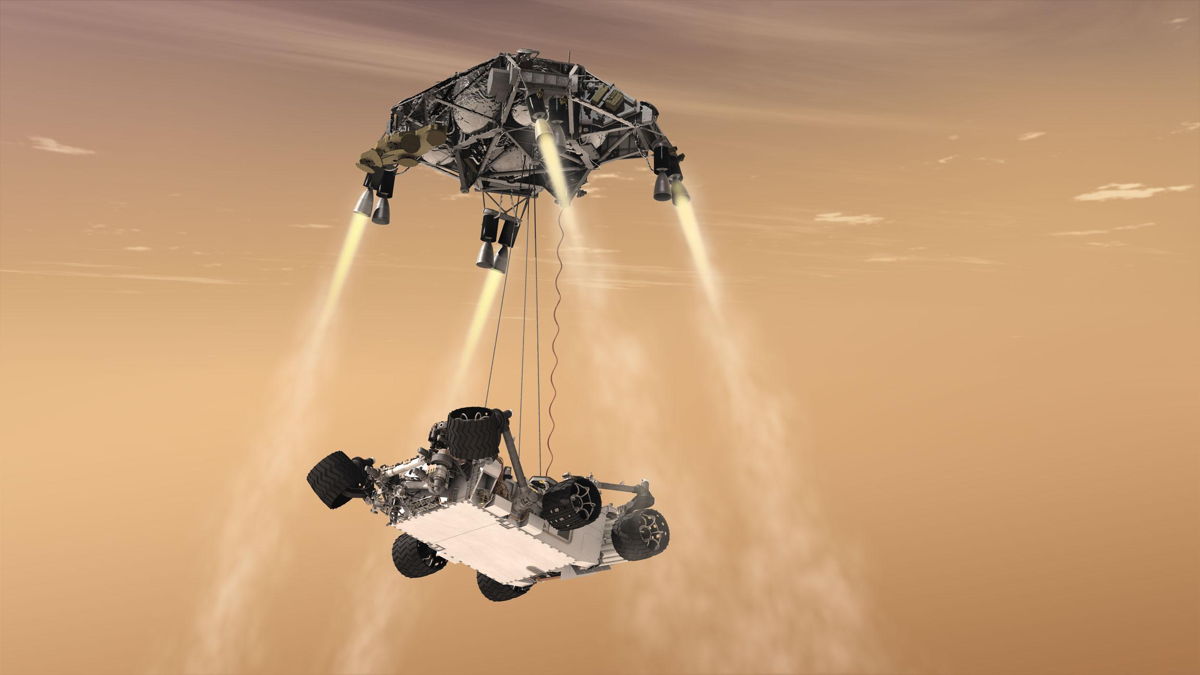
In its first year on Mars, NASA's Curiosity rover has made discoveries that should help pave the way for human missions to the Red Planet in the next few decades, space agency officials say.
The 1-ton Curiosity rover has beamed home useful information about radiation levels on the Red Planet's surface and in deep space. And its harrowing "seven minutes of terror" landing on the night of Aug. 5, 2012 showcased a way to put heavy loads down with precision on another world, NASA chief Charles Bolden said.
"The wheels of Curiosity are literally blazing the trail for human footprints on Mars," Bolden said Tuesday (Aug. 6) during a one-year anniversary celebration for the rover at NASA Headquarters in Washington, D.C. [Curiosity's First Year on Mars in Two Minutes (Video)]
Destination: Mars
The long-term goal of NASA's human spaceflight program is to put boots on the Red Planet. Indeed, President Barack Obama has directed the agency to get astronauts to a near-Earth asteroid by 2025, then on to the vicinity of Mars by the mid-2030s.
Curiosity's mission marks a key step toward making this dream a reality, Bolden said. He cited the "sky crane" landing system that lowered the car-size robot to the Martian surface on cables one year ago.
"Our success in landing a heavier payload on Mars with increased precision brings us closer to developing capabilities necessary for human missions to Mars," Bolden said.
Sign up for the Live Science daily newsletter now
Get the world’s most fascinating discoveries delivered straight to your inbox.
That's not to say, however, that Curiosity's sky crane could be used as-is for manned Red Planet efforts. Much more development work will be required to find a way to lower human habitats and other heavy infrastructure to the surface, officials said.
"We barely are able to do a metric ton now. When we send humans, we're trying to land 40 metric tons," Prasun Desai, acting director of the Strategic Integration and Analysis Office in NASA's Space Technology Mission Directorate, said at the Curiosity anniversary event. "So we're landing a car; what we need to do is a two-story house when we send humans to Mars."
The radiation data Curiosity has gathered will also help plan out manned missions to the Red Planet, Bolden said. The rover measured radiation levels in deep space during its eight-month cruise to Mars, and it has been characterizing the radiation environment on the planet's surface since touching down.
This latter effort is very much a work in progress. But the data so far are encouraging, suggesting that astronauts could endure a long-term, roundtrip Mars mission without accumulating a worryingly high radiation dose, mission scientists announced late last year.
Exploring the solar system
Curiosity's main task is to determine if Mars could ever have supported microbial life. The rover has already accomplished this goal; mission scientists announced in March that an area called Yellowknife Bay, near Curiosity's landing site inside the huge Gale Crater, was indeed habitable billions of years ago.
Curiosity is now rolling toward the base of the 3.4-mile-high (5.5 kilometers) Mount Sharp, which holds a record of Mars' changing environmental conditions in its many layers.
The rover team wants Curiosity to read this history like a book as it climbs up through Mount Sharp's foothills, shedding light on the Red Planet's transition from a relatively warm and wet world long ago to the cold and dry Mars we know today.
Not only is Curiosity "discovering the past of Mars, it's actually making discoveries about what Mars is like today," said Jim Green, director of NASA's planetary science division.
"That's important, because our future is really in our hands," Green added. "Our destiny is to leave low-Earth orbit, trek out into the solar system. The solar system is ours — let's take it. And we believe humans can actually land on Mars as that ultimate destination for humans within 20, perhaps 30 years from now."
This story was provided by SPACE.com, a sister site to LiveScience. Follow Mike Wall on Twitter @michaeldwall and Google+. Follow us @Spacedotcom, Facebook or Google+. Originally published on SPACE.com.











